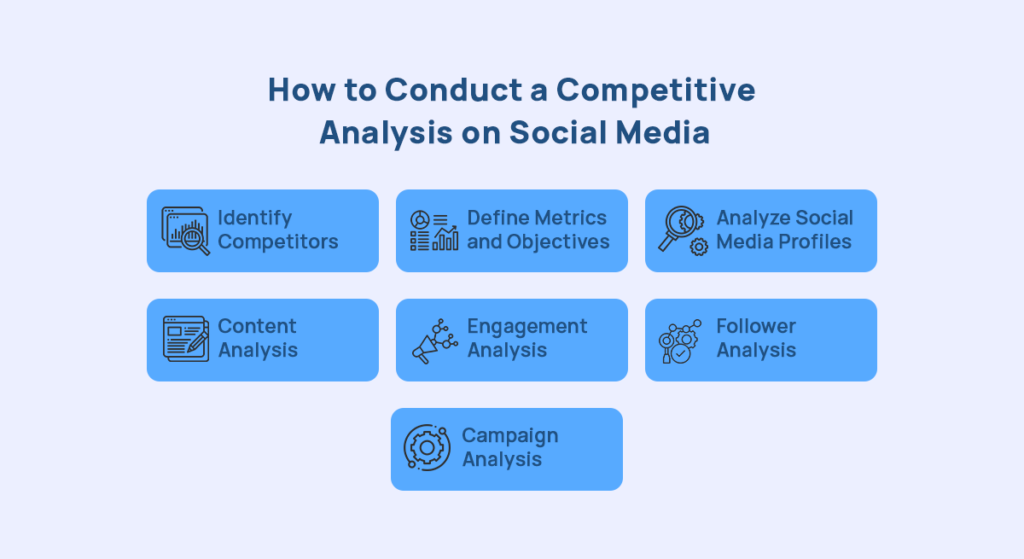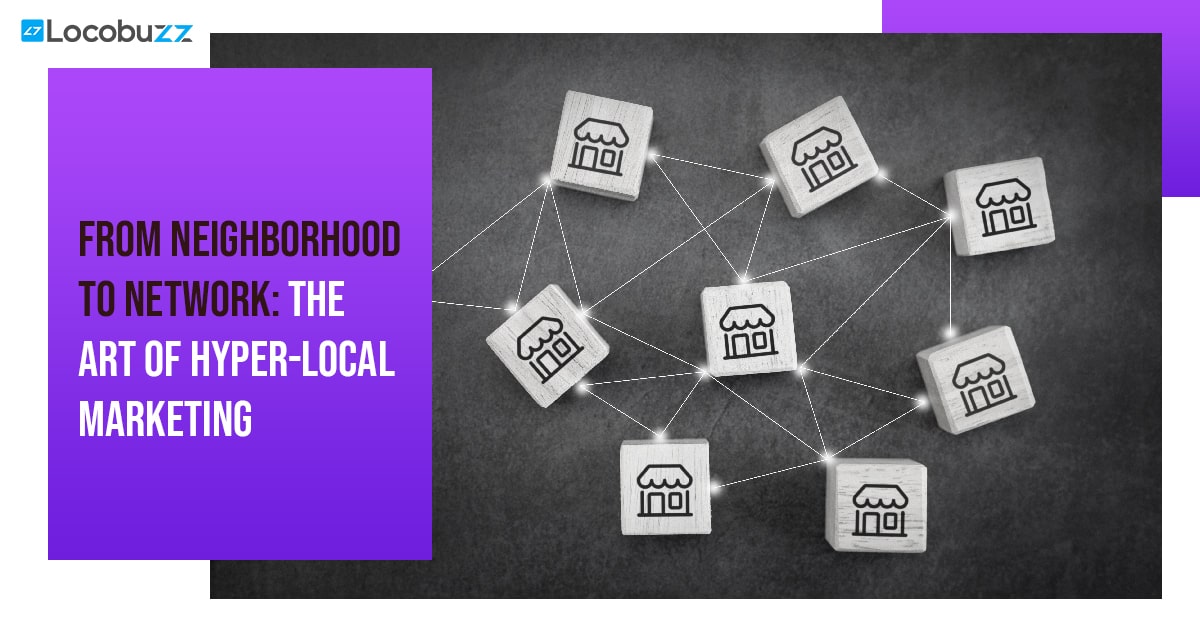Winning the Social Media Battle: A Guide to Effective Social Media Analysis
 In the era of digitalization, social media has become an indispensable platform for businesses to establish a connection with their target audience and establish their brand identity. With the proliferation of social media, the competition has skyrocketed, making it essential for businesses to conduct a social media competitor analysis.
In the era of digitalization, social media has become an indispensable platform for businesses to establish a connection with their target audience and establish their brand identity. With the proliferation of social media, the competition has skyrocketed, making it essential for businesses to conduct a social media competitor analysis.
This process involves scrutinizing your rivals’ social media activities and strategies to assess their strengths, weaknesses, and potential opportunities for your own brand. In this blog post, we’ll delve into the significance of social media competitor analysis and present a comprehensive guide to performing a successful
Table of Contents
What is a social media competitor analysis?
A social media competitor analysis is a process of analyzing your competitors’ social media presence, content, and strategies to gain insights into their strengths and weaknesses. It involves evaluating your competitors’ social media activities to determine how they engage with their audience, what content they share, and how often they post.
The aim of a social media competitor analysis is to identify opportunities for your brand to improve your own social media strategy by leveraging your competitors’ successes and avoiding their mistakes.
By understanding your competitors’ social media activities, you can gain insights into the latest trends, best practices, and audience preferences in your industry. A social media competitor analysis can help you stay ahead of the competition, build brand awareness, and improve your social media ROI.
Why is Social Media Competitor Analysis Important?
Social media competitor analysis is crucial for any business that wants to succeed in today’s digital age. Here are some reasons why it is important:
- Identify Industry Trends:
Conducting a social media competitor analysis can help you stay on top of industry trends and emerging social media practices. By monitoring your competitors’ social media activities, you can identify which platforms and channels are gaining popularity in your industry, and which ones are losing traction. You can also track changes in the type of content that your competitors are sharing, such as videos, live streams, or interactive posts. This information can help you stay ahead of the curve and adapt your social media strategy to meet changing trends. - Gain Insights Into Competitors’ Strategies:
Analyzing your competitors’ social media activities can provide insights into their strategies and tactics. You can learn from your competitors’ successes and mistakes, and use this information to improve your own social media strategy. For example, you can identify which types of content generate the most engagement and which ones fall flat, and adjust your content accordingly. You can also study your competitors’ posting frequency, timing, and voice to get a sense of what works best for your audience. - Understand Audience Preferences:
By analyzing your competitors’ social media activities, you can gain insights into your audience’s preferences and interests. For example, you can analyze the type of content that generates the most engagement and identify the topics that your audience is most interested in. This information can be used to tailor your own content to better meet the needs of your audience. Additionally, you can monitor your competitors’ audience engagement and identify which posts generate the most comments, shares, and likes. This can help you understand what types of content resonate most with your audience and adjust your strategy accordingly. - Stay Ahead of the Competition:
Analyzing your competitors’ social media activities can help you identify opportunities that your competitors may have missed. For example, you can identify gaps in your competitors’ content strategy and fill them with your own unique content. You can also identify emerging trends in your industry and capitalize on them before your competitors do. Additionally, you can analyze your competitors’ audience engagement and identify areas where you can improve your own engagement metrics. By staying ahead of the competition, you can improve your brand’s social media presence and gain a competitive advantage.
Benefits of conducting Social Media Competitor Analysis
In the digital world, social media has become an essential tool for businesses to connect with their target audience and establish brand recognition. However, with the increasing competition, it’s crucial to stay ahead of the game.
Conducting a thorough social media competitor analysis can help you to gain valuable insights into your competitors’ social media profiles, audience engagement, content performance, and advertising strategies, enabling you to make data-driven decisions and boost your own social media performance.
So, make sure to prioritize your social media strategy and conduct a comprehensive competitor analysis to achieve your business goals and stay ahead of the competition. Here are some below listed benefits.
Gain a Competitive Edge:
By conducting a social media competitor analysis, you can gain valuable insights into your competitors’ strategies, tactics, and strengths and weaknesses. This can help you identify opportunities to differentiate your brand and gain a competitive edge. For example, you may discover that your competitors are not utilizing a particular social media platform, providing an opportunity for you to gain an audience on that platform.
Improve Your Social Media Strategy:
A social media competitor analysis can help you identify areas where your social media strategy can be improved. By analyzing your competitors’ social media activities, you can learn from their successes and mistakes, and adjust your own strategy accordingly. This can help you to better engage your audience, increase your social media ROI, and achieve your business goals.
Stay Up-to-Date with Industry Trends:
Social media is constantly evolving, with new platforms, features, and trends emerging all the time. By conducting a social media competitor analysis, you can stay up-to-date with the latest trends in your industry, and ensure that your brand is not left behind. This can help you to stay relevant, attract new audiences, and build your brand’s reputation.
Identify New Opportunities:
Conducting a social media competitor analysis can help you identify new opportunities for your business. For example, you may discover that your competitors are not effectively targeting a particular demographic or geographic area, providing you with an opportunity to expand your audience. By identifying new opportunities, you can improve your brand’s social media presence and generate new leads and sales.
How to Conduct a Competitive Analysis on Social Media

Conducting a competitive analysis on social media can provide you with valuable insights into your competitors’ social media strategies, tactics, and audience. By analyzing their social media profiles, top performing content, audience, and social media campaigns, you can refine your own social media strategy and gain a competitive edge.
- Define Your Competitors
The first step in conducting a competitive analysis on social media is to define your competitors. This may include direct competitors, who offer similar products or services to your business, as well as indirect competitors, who may be targeting the same audience but with different products or services. Once you have identified your competitors, you can begin to analyze their social media activities. - Analyze Their Social Media Profiles
The next step is to analyze your competitors’ social media profiles. This includes reviewing their bio, profile picture, cover photo, and any other information they have included on their social media pages. You should also take note of the social media platforms they are using and the frequency of their posts. - Identify Their Top Performing Content
After analyzing your competitors’ social media profiles, you should identify their top performing content. This includes posts that generate the most likes, shares, and comments. By identifying their top performing content, you can gain insights into the type of content that resonates with their audience. This can help you to refine your own social media strategy and create content that is more likely to engage your own audience. - Analyze Their Audience
It is also important to analyze your competitors’ audience. This includes identifying their demographic characteristics, such as age, gender, and location, as well as their interests and behaviors. You can use social media analytics tools to gather this information. By understanding your competitors’ audience, you can gain insights into your own target audience and tailor your social media strategy accordingly. - Analyze Their Social Media Campaigns
It’s time to scrutinize your competitors’ social media campaigns. This entails inspecting their sponsored posts, social media ads, and all other campaigns they’ve conducted on social media. By delving into their social media campaigns, you can unravel insights into their advertising strategies and techniques. You can also identify any lacunae or opportunities that you can seize in your own social media campaigns. - Evaluate Their Social Media Performance
Once you have analyzed your competitors’ social media profiles, content, audience, and campaigns, it’s time to evaluate their social media performance. This includes assessing their engagement rates, follower growth, and overall social media ROI. By evaluating their social media performance, you can gain insights into the effectiveness of their social media strategy and identify areas where you can improve your own social media strategy. - Identify Opportunities and Threats
Opportunities may include gaps in your competitors’ social media strategy that you can capitalize on, or new social media platforms or features that you can leverage to expand your audience. Threats may include competitors with large social media followings, or trends in your industry that may make it more difficult to engage your audience on social media. By identifying opportunities and threats, you can develop a more effective social media strategy that accounts for both. - Develop Your Social Media Strategy
Based on the insights you have gained from analyzing your competitors’ social media activities and evaluating their performance, it’s time to develop your own social media strategy. This includes setting goals and objectives, identifying your target audience, selecting the social media platforms you will use, creating a content strategy, and determining how you will measure success. By developing a clear and effective social media strategy, you can improve your social media presence, engage your audience, and achieve your business goals.
Metrics to Measure in Social Media Competitor Analysis
Gauging the metrics in social media competitor analysis can be a game-changer in refining your own social media strategy. By tracking an array of metrics, including follower growth, engagement rate, reach, impressions, CTR, and social media ROI, you can gain a competitive edge and improve your chances of social media success. Let’s explore some of the most important metrics to track using Locobuzz.
- Follower Growth
One of the key metrics to measure in social media competitor analysis is follower growth. This metric provides insight into how quickly your competitors are growing their social media following. By tracking follower growth, you can identify trends in your industry and adjust your social media strategy accordingly. - Engagement Rate
Another important metric to measure is engagement rate. This metric measures the level of interaction your competitors are receiving on their social media posts, such as likes, comments, and shares. By measuring engagement rate, you can identify the type of content that resonates with your competitors’ audience and use this information to improve your own social media strategy. - Reach
Reach measures the number of people who have seen your competitors’ social media content. By measuring reach, you can identify the effectiveness of your competitors’ social media campaigns and identify potential opportunities to expand your own audience. - Impressions
Impressions measure the total number of times your competitors’ social media content has been seen. By tracking impressions, you can gain insights into the frequency and effectiveness of your competitors’ social media posts. - Click-Through Rate (CTR)
CTR measures the number of clicks your competitors’ social media content has received. By tracking CTR, you can identify the effectiveness of your competitors’ social media ads and campaigns and adjust your own social media strategy accordingly. - Social Media ROI
Social media ROI measures the return on investment your competitors are achieving through their social media activities. By measuring social media ROI, you can identify the effectiveness of your competitors’ social media strategy and adjust your own social media strategy to achieve a higher ROI.
Common Mistakes to Avoid in Social Media Competitor Analysis
When it comes to conducting a social media competitor analysis, it’s important to be aware of common mistakes that can hinder your efforts to gain valuable insights. These mistakes include overemphasizing vanity metrics such as follower count, and underemphasized meaningful metrics like engagement rate and social media ROI.
It’s also important to consider the context of your competitors’ social media strategy, such as their business size, target audience, and overall marketing goals. Additionally, analyzing only direct competitors and neglecting indirect competitors or emerging players in your industry can limit the scope of your analysis. And finally, failing to keep up with the latest social media trends, such as new features or platforms, can result in missing out on important information about your competitors’ strategies.
Tips and Tricks to Avoid These Mistakes on Social Media Competitor Analysis
It’s important to approach social media competitor analysis with a clear strategy and goal in mind. By defining your objectives and staying focused on meaningful metrics and insights, you can gain a competitive edge and achieve success on social media.
To avoid these common mistakes and conduct a more effective social media competitor analysis, here are some tips and tricks to follow:
- Focus on meaningful metrics that provide insight into your competitors’ social media strategy and overall marketing goals.
- Consider the context of your competitors’ social media strategy and how it fits into their overall business strategy and goals.
- Cast a wider net and analyze both direct and indirect competitors, as well as emerging players in your industry.
- Stay up-to-date with the latest social media trends and features to ensure that your analysis is comprehensive and accurate.
Locobuzz CX Suite for Social Media Competitor Analysis
Locobuzz CX Suite is a cutting-edge social media analytics platform that can empower you with invaluable insights for social media competitor analysis. With its sophisticated social media listening, benchmarking, sentiment analysis, content analysis, and real-time alerts, you can gain an unparalleled competitive advantage and drive exceptional results on social media.
Revolutionary Social Media Listening
Locobuzz CX Suite deploys state-of-the-art social media listening tools to capture and scrutinize social media conversations pertaining to your brand and your competitors. This can enable you to recognize emerging trends, opportunities, and threats in real-time, and fine-tune your social media strategy accordingly.
Benchmarking Against Competitors
Locobuzz CX Suite can enable you to benchmark your social media performance against that of your competitors. This can enable you to identify your strengths and weaknesses in social media strategy, and make astute data-driven decisions to optimize your performance.
Sophisticated Sentiment Analysis
Locobuzz CX Suite leverages advanced sentiment analysis algorithms to decipher the tone and sentiment of social media conversations surrounding your brand and your competitors. This can help you to gauge your competitors’ perception among their audience and tailor your social media strategy accordingly.
Exhaustive Content Analysis
Locobuzz CX Suite can parse through the content of your competitors’ social media posts and recognize the type of content that resonates with their audience. This can help you to craft more effective social media content that captures the interest of your audience and drives compelling outcomes.
Real-time Alerts
Locobuzz CX Suite can send instantaneous alerts when your competitors post new content or receive a high level of engagement on social media. This can keep you abreast of your competitors’ social media activity and enable you to adapt your social media strategy in real-time.
Final Thoughts
Wrapping up, performing a social media competitor analysis is a crucial part of any effective social media strategy. By thoroughly analyzing your competitors’ social media profiles, top performing content, audience demographics, campaigns, and performance metrics, you can gain valuable insights into their social media tactics and make data-driven decisions to boost your own performance.
To conduct a successful social media competitor analysis, it’s important to carefully select your competitors, concentrate on meaningful metrics, take into account the context of their social media strategy, and spot opportunities and threats.
Sophisticated tools such as Locobuzz CX Suite can offer valuable insights for social media competitor analysis. With features such as advanced social media monitoring, competitor benchmarking, sentiment analysis, content analysis, and real-time alerts, you can gain a strategic advantage and excel on social media.
If you’re interested in conducting a social media competitor analysis, give Locobuzz CX Suite a try and kick off the journey to success on social media. With its advanced social media analytics capabilities, you can gain a deep understanding of your competitors’ social media tactics and boost your own social media performance.

















